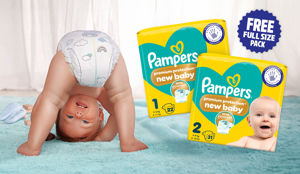Pain in the lower back, hips and/or groin can be diagnosed as pelvic girdle pain (PGP). It affects 1 in 5 pregnant ladies and is most common in the second and third trimesters.
Historically, the pelvis would be described as ‘unstable’ in pregnancy. Hormones (especially one called 'relaxin') were once blamed for everything related to PGP. We now know that hormones play a fundamental part in helping the ligaments to relax in the pelvis in preparation for labour and birth. This does cause some minimal movement around the joints, but the pain you may be experiencing is most likely to be because of a combination of factors.
We shall look at the reasons why you may be experiencing pain and some tips and advice on how to manage it throughout pregnancy.
As we're sure you have noticed, your body is forever changing throughout the course of your pregnancy. Your waistline is expanding, your centre of gravity is shifting and there is now more weight pushing down on your pelvis. Your body is adapting to these incredible changes, and you may have found that your bottom has flattened, the arch in your lower back has increased, and your mid-back feels stiff. All these changes can contribute to the pain that you are experiencing.
Ways to manage your PGP
Decrease Stress
We know that the more stressed and anxious someone becomes, the more they are in pain. Muscles like the pelvic floor can become overactive when someone is stressed, leading to increased pain.
Taking smaller, shallower breaths can also occur (especially as the pregnancy progresses), which in turn increases stress levels. As you can see, it’s a bit of a vicious circle, which can be broken with a bit of work.
Learning how to breathe well (especially in the third trimester when you feel like you have run out of room), is something that can be a key skill for both during pregnancy and afterwards.
To try this, have a sit down so that you are comfortable. Putting one hand on your bump, take a slow breath in through your nose and feel your bump rise into your hand slightly. Everything should be relaxed including your pelvic floor (that’s important).
As you breathe out through your mouth, feel your bump sinking away from your hand. We are now going to try this breath out through the mouth, contracting the pelvic floor at the same time as we covered in our blog on kegel exercises. To contract the pelvic floor, we focus on the back passage first. Imagine you are holding in some wind and squeeze the back passage closed. That feeling of closing and lifting is then brought forwards to the front passage. Imagine now that you are stopping yourself from having a wee. Try not to squeeze your bottom cheeks at the same time though.
It can be quite tricky to coordinate this at first but keep practising and it will come. There are so many advantages to this breath work. We want to make sure that the pelvic floor can both relax and contract effectively, and this is a wonderful way to practise this. By breathing slowly into the tummy rather than a shallow breath into the shoulders, tension will be reduced throughout your whole body.
Functional Movements
Day-to-day movements can be slightly modified to manage your PGP. Many pregnant ladies can reduce their pain considerably by adopting these habits:
- Walking - reducing stride length and not walking past the pain.
- Standing - being aware of how you stand. Try putting an equal amount of weight through both legs and not favouring one side. Trying to tuck your tailbone under slightly (pelvic tilt) will take some of the strain out of your lower back and your deep abdominals will support the weight of your bump a bit more.
- Carrying kids/objects - try to keep whatever or whoever you are carrying in front of you rather than on a hip or in one hand to the side.
- Going up stairs - placing one foot firmly on the stair in front, squeeze that bottom cheek as you breathe out and bring the other foot to join it. No breath-holding and no pulling yourself up with the bannister. Yes, it may seem slow and monotonous, but you are re-educating your brain to use your glute muscles effectively.
- Getting in and out of the car - be 'lady-like' and put your bottom on the seat first and try to bring your legs together and swing round (use your hands if you need it to). It’s the reverse getting out of the car.
- Getting out of chair - slide your heels back, lean forwards, use your hands as necessary to push up with. Before you go to stand, breathe out, engage the pelvic floor (as previously described) and up you go.
- Getting out of bed - roll onto your side, legs out first, use your hands to push you up into sitting position.
- Putting your knickers/socks on - it’s not best to be single leg standing if you have PGP, have a sit down to put them on.
- Sleeping - try putting a pillow between your knees to sleep, as this keeps the pelvis in a neutral position. If there was ever a time to buy some silk nightwear it may be now. Being able to slide whilst turning in bed may be a game changer!
Belt or no Belt?
Support belts can be worn to reduce PGP but can sometimes make it worse if the muscles are overactive.
To test this out get a scarf/towel and wrap it around the outside of the hips (low under the bump). You will know soon if it feels wonderful, or awful! If it feels like it ‘holds’ you well, then it is a great idea to wear either a scarf or belt to decrease your pain so that you can then start some muscle strengthening work to manage your PGP throughout the rest of the pregnancy.
Pain Relief
Painkillers - Taking painkillers regularly throughout your pregnancy won’t harm you or your baby. Paracetamol can be bought over the counter as the first port of call. Stay away from Ibuprofen, however.
Heat/ice - Depending where your pain is, you may prefer using a hot water bottle or an ice pack, either is fine.
Muscle Strengthening and Mobility
Hopefully, once you have consistently done points 1-3, you will find that your PGP reduces, or is at least manageable. It is then time to start strengthening the muscles that have gotten lazy during pregnancy to help support your growing bump.
Most commonly, the glutes (that flat bottom we talked about) need some attention. There are 3 muscles that make up the glutes, 'gluteus maximus' (the powerhouse), the 'gluteus medius' and the 'gluteus minimus' (the stabilising duo).
Seeking out a pelvic health physiotherapist, pregnancy Pilates class, or working with a pregnancy trained personal trainer can be a great help to strengthen them in a way that doesn’t cause you more pain.
Mobility work into the lower and mid-back can really help to ease PGP. Stiffness in the joints and tightness in the muscle can often cause pain.
Exercises to Try
- Cat/cow posture - In a four-point kneeling position on the floor, breathe in. On your breath out, arch your back up like a cat. Lift through the pelvic floor, tuck your tailbone under and pull your bump up towards your spine. Breathe in to hold. Breathe out and return to neutral. Repeat this a few times (e.g., 8-10)
- Thread the needle - In four-point kneeling position, take a breath in. On the breath out, slide the back of the right hand underneath the left arm as far as you can. Breathe in to hold. On the breath out, engage your pelvic floor and bring the right hand back. Switch sides. Repeat again (e.g., 5 to each side).
See a Pelvic Health/Women’s Health Physio
Getting assessed by a specialist physio will give you reassurance as to what exactly is causing your PGP.
They will be able to help release overactive muscles with manual therapy as well as give you a specific home exercise plan to help manage your PGP throughout your entire pregnancy.








